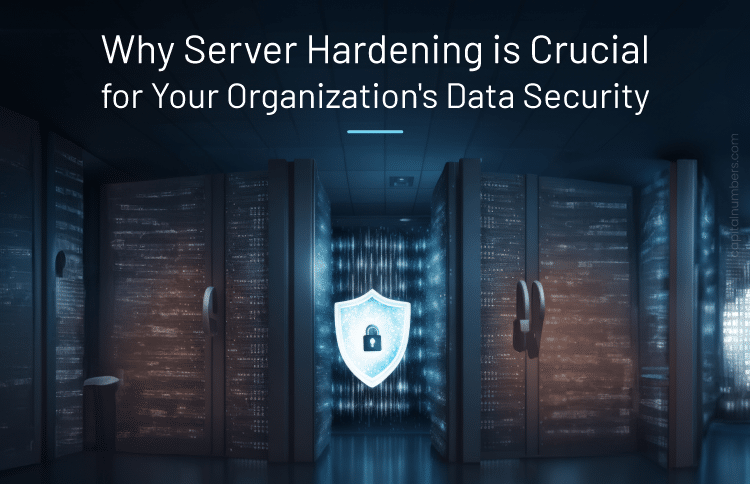Why Server Hardening is Crucial for Your Organization’s Data Security
Table of Contents
In today’s digital world, cyber threats are becoming more advanced and common. Securing your organization’s IT infrastructure is more important than ever. One key part of this security is server hardening. Server hardening means making your servers more secure to protect them from unauthorized access, vulnerabilities, and potential cyber attacks. This article will explain why server hardening is so important, and it will cover the benefits and best practices for strengthening your servers in an organizational setting.
Understanding Server Hardening
Server hardening is the process of improving the security of your servers by reducing their vulnerabilities. This involves configuring your server’s settings, applying updates, and using various tools and techniques to protect against cyber threats. The goal is to make your servers as secure as possible, minimizing the risk of unauthorized access and data breaches.
Common Vulnerabilities in Servers
Servers can have several vulnerabilities that hackers might exploit. Some common vulnerabilities include:
- Default Settings: Many servers come with default settings that are not secure. These settings can include default usernames and passwords, which are easy targets for attackers.
- Outdated Software: Running outdated software or operating systems can leave your server open to known exploits and vulnerabilities that have been fixed in newer versions.
- Open Ports: Servers with unnecessary open ports can be entry points for attackers. Open ports can allow unauthorized access to the server’s resources.
- Weak Access Controls: Poorly configured access controls can allow unauthorized users to gain access to sensitive data or critical system functions.
- Lack of Encryption: Without proper encryption, data transmitted to and from the server can be intercepted and read by attackers.
How Server Hardening Addresses These Vulnerabilities
1. Protection Against Cyber Attacks
- Prevention of Unauthorized Access
Servers are the backbone of an organization’s digital ecosystem, hosting applications, databases, and other critical resources. Unauthorized access to these servers can lead to data breaches, service disruptions, and substantial financial losses. Server hardening involves configuring servers to prevent unauthorized access. This includes:- Strong Password Policies: Enforcing complex passwords and regular password changes to make it harder for attackers to gain access through brute force attacks.
- Multi-Factor Authentication (MFA): Adding an extra layer of security by requiring two or more verification factors to access the server.
- Disabling Unnecessary Services: Reducing the attack surface by disabling services and applications that are not required for the server’s operation.
- Mitigation of Vulnerabilities
Cyber attackers continually seek vulnerabilities in server software and configurations to exploit. Server hardening helps mitigate these risks by:- Regular Software Updates: Ensuring that the operating system and all installed software are up-to-date with the latest security patches.
- Configuration Management: Applying secure configuration settings and regularly reviewing these settings to adapt to new threats.
- Intrusion Detection Systems (IDS): Implementing IDS to monitor network traffic for suspicious activity and potential attacks.
2. Data Integrity and Confidentiality
- Safeguarding Sensitive Information
Organizations often handle vast amounts of sensitive data, including personal information, financial records, and proprietary information. Server hardening ensures this data is protected from breaches, maintaining confidentiality and integrity. Key practices include:- Data Encryption: Encrypting data at rest and in transit to protect it from being intercepted and read by unauthorized parties.
- Access Controls: Implementing strict access controls to ensure that only authorized personnel can access sensitive data.
- Regular Audits: Conducting regular security audits to identify and address potential vulnerabilities in the data handling processes.
- Compliance with Regulations
Many industries are subject to strict data protection regulations such as the General Data Protection Regulation (GDPR) in Europe, the Health Insurance Portability and Accountability Act (HIPAA) in the United States, and others. Non-compliance can result in hefty fines and legal consequences. Server hardening helps organizations meet these compliance requirements by:- Implementing Security Controls: Adopting security controls that are required by regulations, such as encryption, access logs, and secure configurations.
- Documentation and Reporting: Keeping detailed records of security measures and incidents to demonstrate compliance during audits.
3. Enhanced System Performance and Reliability
- Improved System Stability
A well-hardened server is more stable and reliable. This stability is achieved by:- Reducing Attack Surface: By disabling unnecessary services and applications, the server’s exposure to potential attacks is minimized.
- Minimizing Software Conflicts: Ensuring that only necessary software is installed reduces the risk of software conflicts that can lead to system crashes.
- Reduced Downtime
Server hardening directly contributes to reduced downtime by making servers less susceptible to attacks and other issues that can cause outages. This ensures that critical services remain available, enhancing overall operational continuity and productivity. Key measures include:- Backup and Recovery Solutions: Implementing robust backup and recovery solutions to quickly restore services in the event of a failure.
- Redundancy: Setting up redundant systems and failover mechanisms to maintain service availability even if one server is compromised.
4. Cost Savings
- Reduction in Incident Response Costs
Preventing breaches and attacks through proactive server hardening can save substantial costs associated with incident response, legal fees, and remediation efforts. Investing in server hardening upfront reduces the likelihood of costly security incidents. Considerations include:- Proactive Security Measures: Investing in security measures that prevent incidents rather than reacting to them.
- Automated Monitoring: Using automated tools to continuously monitor server security and promptly address any issues that arise.
- Lower Risk of Financial Loss
Protecting servers from cyber threats mitigates the risk of financial losses resulting from data breaches, service interruptions, and potential damage to the organization’s reputation. This includes:- Insurance: Some cyber insurance policies require organizations to implement specific security measures, including server hardening, to qualify for coverage.
- Reputation Management: Avoiding the negative publicity and loss of customer trust that often accompanies a data breach.
5. Building Trust and Reputation
- Customer Confidence
Demonstrating a commitment to security through server hardening helps build trust with customers, partners, and stakeholders. It shows that the organization takes data protection seriously and is dedicated to maintaining the highest security standards. This can be achieved by:- Transparent Security Practices: Communicating openly about the security measures in place to protect customer data.
- Certifications: Obtaining relevant security certifications that validate the organization’s security practices.
- Competitive Advantage
Organizations known for robust security practices often have a competitive edge, attracting clients who prioritize data security. This advantage can be leveraged by:- Marketing Security Strengths: Highlighting the organization’s security measures in marketing materials and customer communications.
- Differentiation: Differentiating the organization from competitors who may not have as strong a focus on security.
You May Also Read: Don’t Get Hacked: Essential Software Security Checklist for Developers
Key Server Hardening Practices
To effectively harden servers, organizations should implement a range of best practices, including:
1. Regular Updates and Patch Management
- Operating System Updates: Ensuring the operating system is regularly updated with the latest security patches.
- Application Updates: Keeping all installed applications up-to-date to protect against vulnerabilities.
2. Configuration Management
- Secure Configuration Settings: Applying and maintaining secure configuration settings for the operating system and applications.
- Disabling Unnecessary Services: Turning off services that are not required to reduce the attack surface.
3. Access Controls
- User Access Management: Implementing strict user access controls to ensure that only authorized personnel can access the server.
- Multi-Factor Authentication (MFA): Requiring MFA for accessing sensitive systems to add an extra layer of security.
4. Firewalls and Intrusion Detection/Prevention Systems (IDS/IPS)
- Network Firewalls: Using firewalls to control incoming and outgoing network traffic based on predetermined security rules.
- IDS/IPS: Implementing IDS/IPS to detect and prevent suspicious activities and potential attacks.
5. Encryption
- Data at Rest: Encrypting data stored on the server to protect it from unauthorized access.
- Data in Transit: Encrypting data transmitted over networks to ensure it cannot be intercepted and read by unauthorized parties.
6. Regular Audits and Monitoring
- Security Audits: Conducting regular security audits to identify and address potential vulnerabilities.
- Continuous Monitoring: Using automated tools to continuously monitor the server for security incidents and respond promptly.
Challenges and Solutions for Server Hardening
1. Keeping Software Up-to-Date
- Challenge: Regularly updating server software and operating systems can be difficult, especially in large environments with many servers.
- Solution: Implement automated update tools to ensure that all servers are running the latest security patches.
2. Managing Configurations
- Challenge: Ensuring consistent and secure configurations across all servers can be complex.
- Solution: Use configuration management tools like Ansible, Puppet, or Chef to automate and standardize server configurations.
3. Balancing Security and Usability
- Challenge: Implementing strict security measures can sometimes impact server usability and performance.
- Solution: Find a balance by implementing security measures that protect the server without significantly affecting its usability. Regularly review and adjust settings as needed.
4. Monitoring and Auditing
- Challenge: Continuously monitoring server activity and conducting security audits can be time-consuming and resource-intensive.
- Solution: Use monitoring tools like Nagios or Prometheus to automate the monitoring process and schedule regular security audits to identify and address vulnerabilities.
You May Also Read: Cybersecurity in the Digital Age: Protecting Your Web Applications from Threats
Conclusion
Server hardening is a vital component of an organization’s overall security strategy. It involves implementing a range of best practices and security measures to protect servers from unauthorized access, vulnerabilities, and cyber threats. The benefits of server hardening are multifaceted, including protection against cyber attacks, ensuring data integrity and confidentiality, enhancing system performance and reliability, cost savings, and building trust and reputation.
By prioritizing server hardening, organizations can create a robust security posture that safeguards their critical assets and supports their long-term success. Investing in server hardening not only protects against immediate threats but also provides a foundation for ongoing security and resilience in the face of evolving cyber challenges.

















